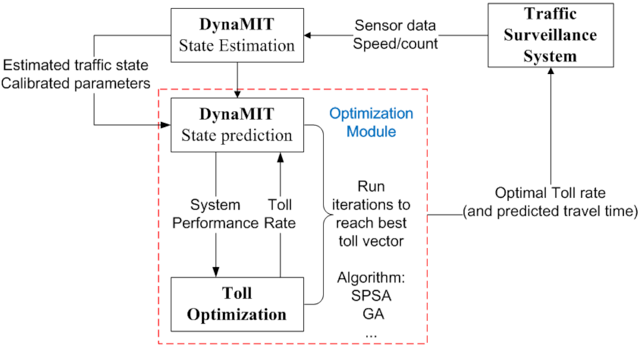Project Manager(s):
Bilge Atasoy (batasoy@mit.edu)
Moshe Ben-Akiva (mba@mit.edu)
Sponsor:
Ferrovial S.A.
Team:
Moshe Ben-Akiva, Bilge Atasoy, Yundi Zhang, Shi Wang (former)
Start Date:
October 2014
Research Highlights:
- This research aims to develop models and algorithms for toll setting
- Dynamic toll optimization is based on real-time prediction of demand and traffic conditions
- A route choice model estimates the demand for toll/managed lanes and free/general purpose lanes.
- The estimation and prediction of the traffic conditions are carried out based on DynaMIT

Abstract:
This research intends to develop models and methodologies for toll setting using dynamic pricing for managed lanes and based on real time prediction of demand and traffic conditions. Appropriate route choice models will be considered in order to estimate the demand for toll and free lanes. The estimation of traffic conditions will be carried out using a simulator. A real-time optimization model will be developed with the choice model and simulator embedded in order to maintain the dynamic prediction of demand and traffic conditions.

FIGURE 2 Closed-loop framework
Description:
Concept:
Congestion pricing is an effective method of demand management. Travelers respond to congestion pricing by changing their behavior in several ways such as changing their route, departure time, mode or even canceling the trip. An appropriate estimation of this response enables efficient control of a transportation network. Dynamic pricing methodologies have recently been the focus of congestion pricing studies where the toll is updated during the day based traffic conditions.
In this project, the dynamic pricing model is based on predicted demand and traffic conditions. The toll rates will be determined based on travelers’ willingness to pay and adapted based on the traffic conditions. The prediction is carried out with DynaMIT and the optimization algorithm is designed such that iterations are performed between the optimization and the DynaMIT prediction for optimizing the toll. High demand during peak hours will correspond with higher toll rates. Conversely, toll rates will decrease when demand is low in order to increase toll lane utilization.
Challenges:
- Calibration of the route choice model
- Development of the real-time dynamic pricing framework
- Improved solution algorithms for achieving real-time computational performance
References:
This project is related to DynaMIT 2.0. To see more information about DynaMIT 2.0, click here.

